Martha's Vineyard, Nantucket, Back Bay
(May 2004)
![]()
My wife invites me to join her for an annual gathering of colleagues over Memorial weekend. Ordinarily, I don't join her, as I get a kick out of attending the Florida Folk Festival in White Springs over this holiday weekend, but this year I leap at the chance to join her, as it is our first wedding anniversary, and the gathering is in the cool air of Boston. (In Florida, we've already suffered from several months of drought and several weeks of furnace-like temperatures.)
Our first stop is my brother's new home in Kingston, Rhode Island. His place is tucked into a very stereotypical New England setting of rolling hills, woodlands, and properties bounded by centuries-old stone walls.
We relish the brisk, moist air that greets us at his place. He takes us to the small fishing village on the coastline-a town called Galilee. We eat at Champlin's Restaurant, a place I am initially disappointed in, as the interior is very campy and low-budget, and uses plastic and Styrofoam for eating utensils on shellacked picnic tables. But the food is delightful. I order and enjoy a VERY fresh and VERY affordable11/4 pound lobster.
Breathing the salty seabreeze as we leave the restaurant, and admiring the docks crowded with well-used cod and lobster fishing boats, I am reminded of Cedar Key, the fishing village on the gulf coast due west of our home in Gainesville.
Our next destination is Woods Hole, MA, where we are to board a ferry for Martha's Vineyard-a place that we have never visited, but heard quite a bit about. Because it is the first day of the holiday weekend, the ferry parking lots are full and we are unable to board the first ferry.
We disembark the ferry and walk directly into Oak Bluffs, a village I have not previously heard the name of. First on the agenda is lunch, and my beer-brewing hobby compels me to have us sample a microbrewery pub in town for lunch. Offshore Ale Co. is a charming, wonderful, "real" kind of place. At the entrance, we are greeted by an enormous barrel full of salted, unshelled peanuts. (Patrons are encouraged to grab a handful as they enter.)
The wood floor is literally covered with the peanut shells that patrons are free to toss on the floor. Old wood boats hang from the ceiling. We order chicken burritos and oatmeal stout-a local microbrew. And I am astonished by how delicious they are.
I admire the gritty, authentic ambience of the place, and vow to return should I visit Martha's Vineyard in the future.
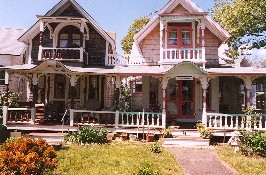
Oak Bluffs turns out to be a very nice surprise. The village is filled with a spectacular, dizzying array of tiny, ornate, brilliantly colorful gingerbread cottages (photo at right). Along these neighborhood streets, walkability is exceptional, as exemplified by the well-used porches in front of the cottages, which butt up against the sidewalks and tiny streets.
Adding to the charm of the village are the many pedestrian-only paved and tree-canopied walkways that wind through the village.
These elements form an enviably quaint, human-scaled, quiet neighborhood setting. "Third Places" such as pubs, restaurants and taverns are abundant. As we stroll through this real-world fairyland, I think to myself how much I would enjoy living in such a setting. But the setting is clearly so high quality that the housing is surely unaffordable to mere peasants such as ourselves.
Before leaving the village, I am unable to resist returning to Offshore Ale for another pint of Oatmeal Stout. I make a promise to myself that I will brew my own oatmeal stout when I return to Florida...
We rent bicycles and discover that the bike ride to Vineyard Haven down the street from Oak Bluffs is short but fairly hostile to bicycling, as the roads are narrow, without bicycle lanes, and crowded with motorists driving at uncomfortably high speeds (perhaps only an artifact of holiday weekend tourists, I hope).
Vineyard Haven turns out to be a bit of a disappointment in comparison to Oak Bluffs. The town seems to be characterized by a collection of large-lot "stately Wayne Manors" (as Batman would say). The homes are surely in the multi-million dollar price range, and are laid out to be less focused on walking and more focused on conspicuous consumption.
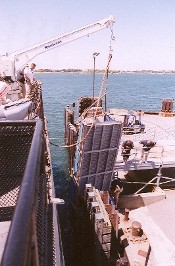
Our departure from Martha's Vineyard provides an exceedingly rare (and for the ferry staff, embarrassing) event. Less than 60 seconds after we cross the gangway connecting the ferry to the dock, we hear a loud commotion. Voices yelling for folks to move away from the boarding area. Then a loud, metallic crash. Quickly, I run to look down from the ferry to the dock.
One end of the gangway HAS FALLEN INTO THE WATER and the other end DANGLES FROM THE FERRY.
Turns out that the rope tie-down to lash the ferry to the dock has come undone, and the ferry had moved away from the dock, sending the gangway into the water. Fortunately, passengers had gotten off the walkway in time, but it takes upwards of 40 minutes for the red-faced ferry staff to use a lifeboat winch crane (photo at left) to lift the gangway away from the ferry so that the boat can depart.
Oops.
From then on, we look carefully at how secure the ropes are that hold the ferries we board to the docks.
The next morning, we ferry to the "Promised Land" of Nantucket. For most of my professional career, I have heard rave reviews of the spectacular urban design found in Nantucket.
I now see why.
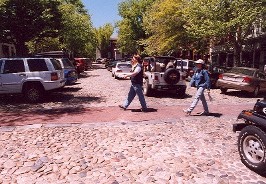
Slow-speed, modestly-sized cobblestone and granite-block surfaces are found on many of the downtown streets. A great many homes and businesses are sided with unpainted "Cape Cod" wood shakes (interestingly, I notice that a number of these buildings have only their front façade painted, while their sides and rear remain unpainted).
Speaking of paint, while we walked the neighborhoods it seemed as if every building was being scrapped or painted, as if such activity is a continuous process in the town.
Downtown Nantucket is remarkably compact and walkable (photo at left & below right). All the buildings are pulled up close to the street. They face the street with entrances and windows. Horse-hitching posts are frequently found on sidewalks, and I wondered how long it had been since they had been used. A good number of widow's walks, picket fences and white picket front porches grace Nantucket Town. An impressive number of the streets feature buildings that terminate vistas. Alleys are frequent and tiny-and often brick.
Overall, Nantucket is exceptionally romantic.
Coincidentally, as we are walking down a street, I hear someone yell my name. I ignore it. After all, who could possibly know me in a place thousands of miles from where I live? But then I feel a hand on my shoulder. It turns out that an architecture student from Gainesville, who I met a few months ago (and who I traveled with to Copenhagen on a student field trip), just happened to be in Nantucket for another student project. (Wow. I don't at all recall my own school field trips including exotic places like Copenhagen and Nantucket...)
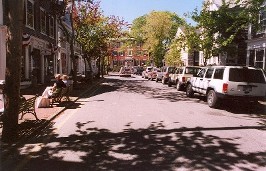
Reminiscent of Charleston, a great many of the bricked sidewalks in Nantucket are noticeably narrow. Which again shows that a community can be highly walkable WITHOUT sidewalks of ample width.
We jump on a public bus ($1.25 fare) to get to Sconset, a small village on the southeast side of Nantucket Island. There, we are again astounded to find a town filled with tiny, tiny dollhouse cottages-some so small that I am able to stand next to the home and touch the roof shingles (photo below).
Curiously, we don't see any kiddy "tourist trains" or horse-drawn carriages on Martha's Vineyard or Nantucket Island, nor do we see evidence of Anywhere USA fast food chains. Having just authored a book entitled "Road to Ruin," it warms my heart to see healthy levels of congestion on both islands, and I feel confident that there would be no desire to ruin their special places by widening their roads. No, they instead appear to be committed to the tradition of designing for people instead of cars.
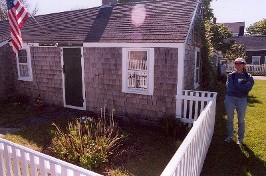
After ferrying back to the mainland, we decide to dine in Hyannis. Despite the abundance of surface parking lots, the Main Street is relatively impressive, as the asphalt parking lagoons are tucked away on "B" streets away from Main Street. On Main Street in contrast to the secondary "B" streets, pedestrian quality is emphasized (rather than Ford Explorer quality...).
In Hyannis, we decide upon the Roadhouse Café, based on a recommendation we had gotten earlier from our extremely helpful bed & breakfast hostess in Centerville. The Café provides a high-quality dining experience.
Afterwards, we stop at a "British Pub," where I am able to enjoy a beer I had recently fallen in love with while in San Francisco: Beamish Stout.
As we leave our B&B the next morning, we again experience a very rare event. As we drive through the morning fog, we spot an adult fox approximately 20 feet in front of our car poised motion-less for approximately 30 seconds. All of his attention is directed toward the wooded shoulder of the road-not our approaching car.
We suddenly discover why.
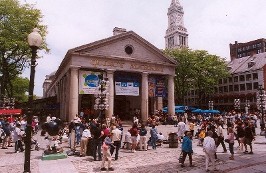
With blinding speed, the fox darts into the woods to our right, snatches a large squirrel in his jaws, and violently shakes the hapless squirrel as he prepares for his morning meal. I begin to wonder if we are on that old "Wild Kingdom" television program.
Before leaving the Cape, we visit another famed urban design place of worship: Mashpee Commons. Mashpee is an inspiring transformation of a conventional shopping center/mall into a walkable, open-air town center. There is hope after all that America can emerge from this "United Parking Lot of America" quagmire we have found ourselves in for the past several decades.
Upon returning our rental car at the Boston airport, we hop on to the "T" subway train. Compared to America's best subway-Metro in DC-the "T" is old, grimey, rundown, and screeching loud. (A notch above the NYC subway, however.) Despite its faults, the "T" is reasonably easy to use for a newcomer. It is reasonably affordable. And it is fairly fast.
With my wife attending a conference, I have most of the day to myself. I first decide to have a look at Quincy Market and Fanueil Hall, a place I have not seen since my high school days over 25 years ago (photo above). I discover that these markets are much more corporate, flashy and antiseptic than they had been in their previous, more authentic and local life. It remains vibrant, pleasant and bustling with people, and unlike 25 years ago, now has "busker" street performers which attract hundreds of onlookers.
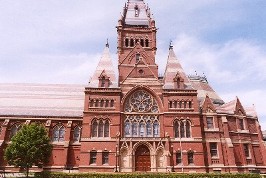
Next stop is a look at the Harvard campus. A place of storied intellectual tradition. I feel humbled by the giants who have been a part of this institution (photo at left).
In my downtown exploration, construction of the multi-billion dollar "Big Dig" project (undergrounding the main highway in downtown Boston) is extremely evident, with dark blue and yellow-banded barricades on countless streets.
For my last foray in Boston, I had explored the glorious urbanism of the Beacon Hill neighborhood. Today, I opt to experience another walkable gem I've heard so much about: Back Bay.
This neighborhood turns out to be all it has been touted to be. Superbly walkable. A wonderful mix of brownstone walk-up rowhouses, offices, restaurants and retail. Human-scaled streets with on-street parking, and a thick and healthy canopy of leafy street trees. Often, narrow one-lane alleys are found between streets.
Again, I feel envy as I look with admiration at the textures, ornamentation and colors of rowhouses and bricked sidewalks in front of me. I quickly shoot through a few rolls of film. In particular, I am impressed by the neighborhoods between Arlington Street and Massachusetts Avenue-especially on Newbury Street and Marlborough Street.

Most of the Back Bay streets are quaint, quiet, and joyous places to walk (photo at right). However, I find Beacon Street-a higher-speed, multi-lane one-way street-to be somewhat inhospitable. The pedestrian experiences less of a sense of street enclosure so important to a quality urban walking experience.
The Back Bay neighborhood, like most of what I experienced in other parts of downtown Boston, and unlike other large cities such as Rome, New York and DC, is relatively quiet and free of emergency vehicle sirens, honking car horns, and loud motorcycles and mopeds. The Commonwealth Avenue Mall, an esplanade which runs east-west and splits the Back Bay neighborhood in half, is a pleasant, green respite populated with lovers on a stroll, joggers, and seniors walking dogs.
Back to Dom's Voyages and Adventures page.